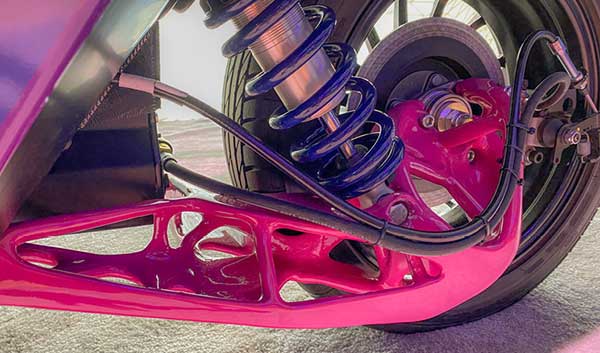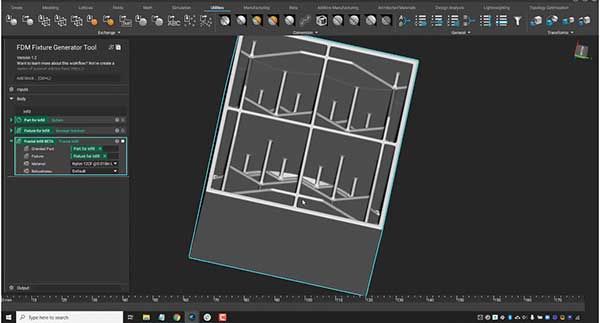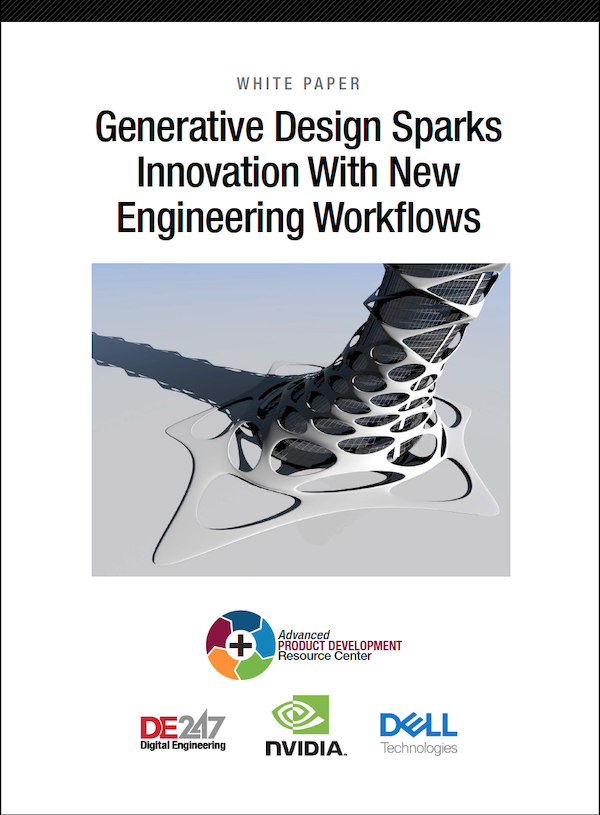Generative Design: A Heavyweight for Lightweighting with Additive
The combination of generative design software and AM technologies is proving to be a go-to force for lightweighting and parts consolidation strategies.

As part of a generative design lightweighting exercise, Arcimoto and XponentialWorks reduced the weight of a swing arm part by about 34%. Image courtesy of XponentialWorks.
Latest News
March 1, 2021
The Silicon Valley Hyundai engineering team that works on Elevate, a walking concept car, is continually coached as if they’re on a perennial diet. Attention to weight is the team’s marching orders: If someone specs a connector to send a signal, it raises automatic questions about if a wireless signal is sufficient. It’s the same design mentality for fasteners—use glue or explore parts consolidation—and even reconsider paint when it’s possible to substitute dyed plastic.
The team, part of Hyundai Motor’s CRADLE corporate venturing and open innovation business, is designing a new class of electric ultimate mobility vehicles (UMVs) from a blank slate with the goal of shaving 500 kg from conventionally-designed vehicles of a similar size. Elevate, along with the Tiger cargo transport variation revealed in February, must climb a 5-foot wall, walk over diverse terrain and drive at standard highway speeds—all while keeping its body and passengers level.
With such specific objectives, lightweighting is one of the bedrock design strategies, and generative design tools paired with additive manufacturing (AM) technologies have become a invaluable staple.
“Every ounce counts—nothing is off limits,” said John Suh, Hyundai vice president and founding director of Hyundai’s New Horizons Studio, the car manufacturer’s innovation incubator. Suh is the executive sponsor of the UMV project.
“We’re designing something that has never been designed before so we need to look at new ways of solving the problem. If we use the same methods, there’s less chance of getting something that hasn’t been done,” he says.
A Synergistic Relationship
The Hyundai team, like countless engineering organizations across industry sectors, prioritizes lightweighting design strategies as a way to reduce costs, improve product performance and simplify production through parts consolidation.
Generative design software, known for its ability to churn out organic, nature-inspired shapes, is a natural force for lightweighting parts or rethinking existing components with the goal of reducing mass and materials without impact to structural integrity.
When engineering firms pair it with additive manufacturing (AM), which can output the organic shapes not possible with conventional manufacturing methods such as casting or injection molding, they can find a sweet spot to achieve lightweighting goals.
“AM and generative design are two sides of the same coin,” says David Busacher, senior engineering consultant with Stratasys. “AM is adding material where it needs to be, and generative design is adding design where it needs to be. “They really are the consummate match because with generative design, a lot of the complex geometries can’t be traditionally manufactured.”
The combination of AM and generative design is instrumental for parts consolidation, another design strategy directly relevant for achieving lightweighting objectives. The opportunity to come up with unique shapes that fully integrate multiple parts into a single assembly has huge ramifications for reducing weight, costs and more, according to Avi Reichental, founder, CEO, and chairman of XponentialWorks.
“The ability to harness algorithms with infinite computing power along with AM opens the possibility for significant lightweighting, significant leaning of the supply chain, reduction of part counts, and increasing the structural performance and overall product performance,” Reichental says.
XponentialWorks put the dynamic duo to work in a partnership with Arcimoto, a startup that develops a line of lightweight, electric fun utility vehicles (FUVs). The joint project is experimenting with different 3D printing technologies and the CogniCAD generative design software from Paramatters to decrease the overall vehicle weight with lightweighted components. So far, the team has reduced the weight of a rear swing arm by 34%, an upper control arm by 52% and a brake pedal by 49%, Reichental says.
“In 30 days, we dropped 30 lbs. out of the product, which is a significant reduction in weight for a vehicle in this class,” says Mark Frohnmayer, Arcimoto CEO.
While the team targets specific parts, the next step is to do an optimization pass to reduce the weight and complexity of the overall vehicle through part re-examination, Frohnmayer says. The original vehicle weighed in at 1,300 lbs. and the goal is to get to 1,100 lbs. to target the micro-mobility class. While AM was optimal for creating early prototypes, Frohnmayer says the company will have to evaluate cost trade-offs between AM and more traditional manufacturing technologies for mass production with help from the XponentialWorks.
Even without AM as the ultimate output measure, generative design can have a big impact on lightweighting. The software automates the iteration process—instead of having a person manually make decisions on where to remove or add material, the algorithm automatically goes through the process, based on input parameters and constraints and building and iterating the outcomes.
At the same time, however, engineers need to understand that many of the lightweight shapes that generative design tools produce aren’t necessarily a candidate for 3D printing right out of the gates—often, they are used to jumpstart the process by giving engineers a guidepost for refining and evolving ideas using their own institutional knowledge.
“The process informs engineers from a physics perspective about what to cut out—otherwise the engineer has to put their finger to the wind and start carving out a design,” Busacher says. “It gives ethos to what the next iteration will be.”
Stratasys is doing many things to build confidence in AM for producing lightweight, and potentially generatively created, designs. Quality is key generative design and AM adoption, and Stratasys has built confidence via the F900 printer and materials, according to Busacher.
In addition, through a partnership with nTopology, the company released the FDM Fixture Generator, which combines Stratasys’ 3D printing expertise with nTopology’s generative design and automation capabilities for a tool that streamlines the design of fixtures for producing lightweight parts.
Autodesk continues to improve Fusion 360, specifically in the area of generative design, to make it the central tool for AM, according to Paul Sohi, product marketing manager for the company.

This effort includes support for the 3MF file format, an XML-based data format specific for AM that stores more granular information than the STL format, as well as a partnership with Xometry to incorporate a price and quote engine directly into the CAD platform; the engine also helps optimize the complementary technologies for production use cases.
For Dassault Systèmes, generative design and AM are wed through the 3DEXPERIENCE platform, which breaks down the barriers that have traditionally handicapped these design workflows via a unified data model and common user experience, explains Colin Swearingen, industry process consultant at Dassault.
Traditionally, different people use different tools throughout the design workflow to achieve lightweighting—for example, CAD, CAE and optimization software—and engineers have to tie together the different models and data in a streamlined workflow to reap the benefits.
“It’s about tying together all aspects of engineering into a common environment so you can accomplish tasks on a single data model,” Swearingen says.
Challenges Ahead
Lightweighting with generative design software and AM is relatively new ground, so most engineering organizations are still feeling their way around to choose the right tool, define optimal workflows and code best practices. One of the biggest miscues organizations make is to over rely on technologies, treating both as a black box that magically outputs the consummate lightweight part at the press of the button. The truth is it’s much more complicated than that.
Engineers must fully understand and define their lightweighting goals and constraints to properly direct the generative tool software as well as understand material properties, support structures and what’s going on inside 3D printers so they can produce optimized, high-quality parts.
“Algorithms are not yet at parity with respect to what people can achieve, especially in the area of anticipated loading conditions,” says Patrick Dunne, vice president of application development for 3D Systems, describing a tool’s propensity to remove all excess material without the benefit of human guidance.
“If you’re approaching the very edge of catastrophic failure, you need to still have the human element of review and expertise. Algorithms are really just tools you use; you can’t rely on them 100 percent,” he says.
Taking a systems-level approach to lightweighting is another important best practice, along with rethinking the design process so that engineers and analysis specialists are working more collaboratively as part of a seamless and automated workflow, says Brad Rothenberg, CEO of nTopology.

Instead of 3D printing existing parts, the right strategy is to re-envision those parts through the lens of consolidation to find lightweighting opportunities. Similarly, a lot of companies zero in on a single part redesign or component instead of looking at the entire system for lightweighting opportunities.
That reluctance to change points at the number one challenge organizations face as they pursue lightweighting strategies: The organization at large simply isn’t open to new ideas, tools or design methodologies. For Hyundai, addressing the culture is somewhat easier given that Suh’s group is part of an innovation center and is tasked with building something entirely new from scratch.
Still, Suh emphasizes the importance of educating and promoting a new mindset, with the understanding that it’s all new terrain and unfolding as a work-in-progress. That’s certainly true with how Suh is proceeding with AM and generative design. The two technologies have advanced the lightweighting ball on the initial scale models, but Suh doesn’t rule out using conventional manufacturing options if they prove to be more effective.
“Begin with all the options on the table for design, whether that’s traditional or generative design, and also consider AM as an option,” Suh says. “From that point, it takes experimentation and thinking through the practical limitations in terms of the materials available for AM, the design tolerances we can achieve through AM, and the economics.”
More 3D Systems Coverage
More Autodesk Coverage
More Dassault Systemes Coverage

Subscribe to our FREE magazine, FREE email newsletters or both!
Latest News
About the Author
Beth Stackpole is a contributing editor to Digital Engineering. Send e-mail about this article to [email protected].
Follow DE







